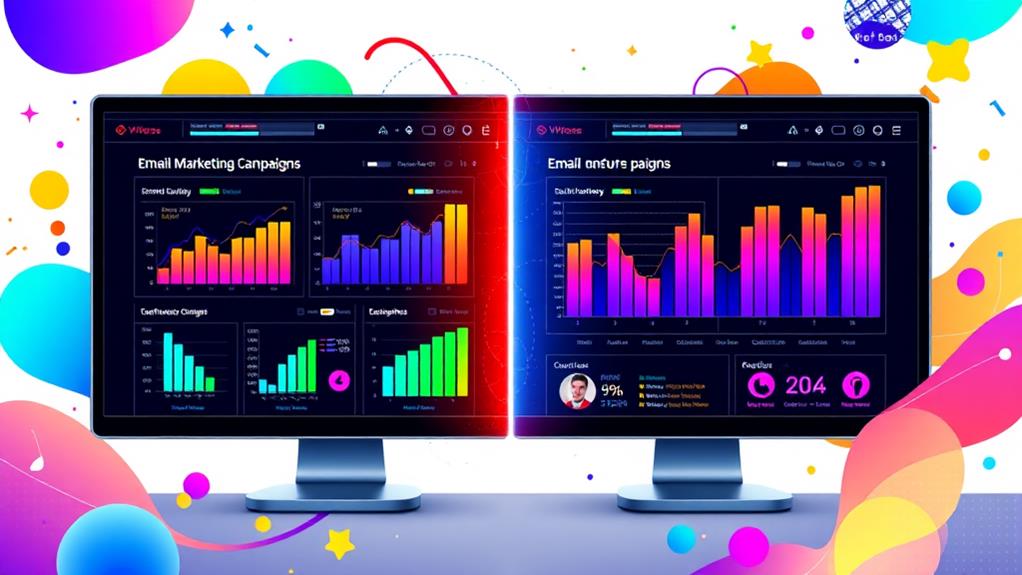For higher open rates in 2024, marketers should employ advanced email segmentation strategies integrating AI-driven dynamic segmentation and predictive analytics. Dynamic segmentation, enhanced by machine learning, has the potential to boost open rates by up to 39% by delivering highly relevant content. Predictive analytics further refines targeting, leading to precision in messaging and a 20% increase in open rates. Effective personalization through tailored subject lines can raise engagement by 22%. However, caution must be taken to avoid over-segmentation, which could dilute messaging. Mastering these tactics can greatly enhance engagement and offer deeper insights into optimizing email campaigns.
Key Takeaways
- Implement AI-driven dynamic segmentation for real-time user behavior analysis to enhance targeting and boost open rates by up to 39%.
- Utilize predictive analytics to refine audience segmentation, leading to open rate increases of up to 20% through precise targeting.
- Personalize email subject lines using recipient names to increase open rates by 22% and improve engagement.
- Optimize campaign timing with predictive insights, achieving up to 39% higher open rates by aligning with user behavior patterns.
- Avoid over-segmentation to maintain messaging clarity and focus on meaningful segments for improved campaign impact.
The Power of Email Segmentation
Revealing the true potential of email marketing hinges notably on the strategic practice of email segmentation. This powerful approach divides audiences into smaller, more defined groups based on specific criteria, resulting in targeted email marketing campaigns that dramatically enhance engagement rates.
According to the DMA, segmented campaigns can lead to a staggering 760% increase in email revenue. This is primarily due to the effectiveness of personalized emails, which boost open rates by 82% and click-through rates by 75%, as reported by SaleCycle.
Advanced segmentation goes beyond basic demographic data, incorporating customer behavior and predictive analytics to craft messages that resonate on a deeper level. By understanding and anticipating customer needs, businesses can improve conversion rates considerably.
However, the precision of segmentation must be balanced; over-segmenting could dilute the messaging and overwhelm recipients, negatively impacting campaign performance.
A/B testing serves as a vital tool in this scenario, allowing marketers to refine their segmentation strategies continuously. This iterative process guarantees that targeted communications maintain their effectiveness without overburdening the audience.
Implementing a data-driven, insightful approach to email segmentation is fundamental for maximizing the return on investment in email marketing campaigns.
AI-Driven Dynamic Segmentation
AI-driven dynamic segmentation leverages real-time user behavior analysis and machine learning automation to optimize audience targeting, resulting in substantial improvements in engagement metrics.
By processing extensive data sets to identify customer behavior patterns, machine learning algorithms enable businesses to increase open rates by up to 39% through highly relevant content delivery.
This approach not only allows for the continuous refinement of segmentation strategies but also guarantees that email marketing efforts are closely aligned with evolving consumer preferences and behaviors.
Real-Time User Analysis
In the rapidly evolving landscape of digital marketing, real-time user analysis stands as a pivotal strategy for achieving effective email segmentation. By leveraging real-time user behavior insights, businesses can implement advanced email segmentation techniques, ensuring that personalized content reaches the right audience at the most opportune moment. This approach capitalizes on machine learning to dynamically adjust segmentation based on current engagement, leading to targeted emails that boast up to 39% higher open rates compared to their generic counterparts.
Utilizing machine learning, marketers can efficiently manage and analyze large datasets, uncovering nuanced patterns in customer behavior that enhance targeting precision. This dynamic segmentation process not only improves the relevance of email content but also greatly boosts engagement metrics.
Real-time monitoring of these metrics can increase click-through rates by up to 25%, providing marketers with actionable insights to optimize their communication strategies continuously.
Implementing AI-driven dynamic segmentation empowers businesses to connect more effectively with their audiences, driving higher conversion rates and fostering customer loyalty. As digital marketing continues to evolve, the ability to harness real-time user analysis will become increasingly essential for brands seeking to maintain a competitive edge and achieve superior email campaign performance.
Machine Learning Automation
Building on the transformative potential of real-time user analysis, machine learning automation stands as a cornerstone in refining email segmentation strategies. By automating the segmentation process, machine learning empowers marketers to efficiently analyze vast datasets, uncovering intricate patterns in customer behavior that inform dynamic segmentation. This approach supports the creation of targeted emails, finely tuned to resonate with individual preferences, thereby enhancing the effectiveness of personalized communication. Dynamic segmentation techniques, driven by AI, have demonstrated the capacity to raise open rates by up to 20%, highlighting the profound impact of leveraging advanced algorithms.
| Benefit | Impact |
|---|---|
| Dynamic Segmentation | +20% Open Rates |
| Real-Time Insights | +39% Higher Open Rates |
| Engagement Metrics Monitoring | +25% Click-Through Rates |
| Continuous Campaign Refinement | Sustained Engagement Levels |
The strategic use of AI-driven dynamic segmentation not only maximizes audience engagement but also guarantees that campaigns evolve alongside subscriber behaviors and preferences. Regular monitoring of engagement metrics through intelligent systems further boosts click-through rates by 25%, underscoring the importance of data-driven decision-making. As marketers adopt these sophisticated techniques, they are better positioned to deliver highly relevant content, ultimately driving success in email marketing campaigns through meticulous, machine-learning-enhanced segmentation strategies.
Personalization Techniques for Engagement
Although often overlooked, the power of personalization in email marketing cannot be overstated, as it plays a pivotal role in driving engagement and fostering customer loyalty.
Personalized emails have been shown to increase open rates by an impressive 82%, underscoring the critical impact of tailored messaging on a targeted audience's interaction. By incorporating recipient names into subject lines, marketers can boost open rates by an additional 22%, demonstrating the effectiveness of personalization in capturing attention.
Segmentation is key to crafting content that resonates with individual preferences, ensuring that communications are not only relevant but also compelling. This targeted approach enables marketers to harness the full potential of personalization, leading to higher engagement levels.
Additionally, the use of urgency-driven tactics within the email content can prompt immediate action, greatly enhancing overall engagement.
Incorporating emotive language into subject lines can further create a sense of exclusivity, compelling recipients to engage with the email. Remarkably, 76% of consumers are more likely to repurchase from brands that consistently deliver personalized communications, highlighting the considerable role personalized content plays in nurturing long-term customer relationships.
Therefore, personalization is indispensable for achieving superior open rates and engagement.
Crafting Effective Subject Lines
Crafting effective subject lines is an art that combines data-driven insights with creative innovation. Personalized subject lines, integrating the recipient's name, can boost open rates by 22%, underscoring their significance in driving engagement within email campaigns.
By aligning subject lines with audience preferences, marketers can deliver relevant content that resonates deeply, resulting in an impressive 82% increase in open rates. Employing emotive language, subject lines can convey exclusivity and urgency, such as "Limited Time Offer," effectively prompting immediate engagement.
A/B testing is a critical tool for refining subject lines, offering actionable insights into what captivates the audience most. By experimenting with variations, marketers can identify high-performing elements, thereby optimizing future campaigns to enhance performance.
This iterative process not only sharpens the effectiveness of subject lines but also aligns them more closely with audience preferences, fostering deeper engagement.
Ultimately, the key to successful subject lines lies in their clarity and conciseness, ensuring they communicate the intended message swiftly and compellingly.
This strategic approach, combining personalization, emotive language, and data-driven testing, positions email campaigns to achieve superior open rates and sustained audience engagement in 2024.
Utilizing Real-Time Data
Harnessing the power of real-time data in email marketing allows businesses to dynamically segment their email lists based on the most current user behavior, resulting in highly targeted campaigns. This approach to email segmentation is essential in boosting open rates by as much as 20%, as it tailors content to meet the immediate needs and interests of recipients.
AI algorithms play an important role by processing vast amounts of real-time data to identify customer behavior patterns. This enhances the precision of segmentation, ensuring personalized emails that resonate deeply with recipients.
Emails crafted from real-time insights have achieved open rates as high as 39%, markedly surpassing those from static segmentation methods. By continually monitoring engagement metrics, businesses can increase click-through rates by 25%, ensuring email content remains relevant and engaging.
This dynamic segmentation is not just about improving numbers; it's about adapting strategies swiftly to maintain the relevance of communication. Marketers can respond to changes in customer behavior as they happen, crafting timely messages that maintain high open rates.
Consequently, leveraging real-time data enables a more responsive and effective email marketing strategy, fostering stronger customer relationships and improved engagement.
Predictive Analytics in Campaigns
Predictive analytics revolutionizes email marketing by enhancing targeting precision through the strategic use of historical data and complex algorithms.
By forecasting engagement patterns, marketers can optimize campaign timing, resulting in open rate increases of up to 20% and markedly improved customer retention.
This data-driven approach not only allows for the creation of dynamic segments based on anticipated actions but also contributes to a reported 30% surge in revenue, illustrating its profound impact on return on investment.
Enhancing Targeting With Data
In the domain of digital marketing, data-driven decision-making is transforming how businesses engage with their audiences. This evolution is prominently seen in email segmentation, where advanced segmentation strategies harness the power of predictive analytics and behavioral data to craft highly personalized content. By doing so, marketers greatly increase open rates and foster deeper connections with their target audience.
Predictive analytics enables businesses to leverage historical data and user behavior patterns to forecast future actions, thereby identifying segments more likely to engage with specific campaigns. Utilizing predictive models, companies can achieve a 20% increase in open rates by tailoring emails to anticipated customer preferences. This approach guarantees that content resonates with engaging subscribers, ultimately enhancing the effectiveness of email marketing strategies.
Additionally, by analyzing past interactions, businesses can determine the best send times and content types, leading to a 39% increase in overall email engagement. The integration of AI-driven predictive analytics tools automates segmentation processes, reducing manual effort and increasing campaign efficiency by up to 25%.
Companies adopting these advanced strategies report a 15% higher conversion rate compared to those relying solely on traditional methods, underscoring the importance of improving targeting with data.
Forecasting Engagement Patterns
Some marketers have discovered the transformative power of predictive analytics in shaping email campaigns that resonate with their audience. By leveraging historical data, predictive analytics allows for the forecasting of engagement patterns, which is essential for effective email segmentation. This approach enables marketers to tailor messages precisely to customer preferences, thereby increasing open rates.
Through the analysis of past open rates, click-through rates, and user interactions, predictive models identify segments more likely to engage, resulting in a more targeted approach. Implementing predictive analytics has been shown to enhance email campaign performance by 10-15%. This improvement is achieved by aligning email content with audience behaviors, rather than relying solely on traditional segmentation strategies.
Machine learning algorithms play a vital role, continuously refining predictions by examining real-time engagement data. This dynamic adjustment guarantees that messages remain relevant and aligned with the shifting preferences of recipients.
Studies indicate that organizations using predictive analytics are 1.6 times more likely to experience a significant boost in customer engagement. As predictive analytics continues to evolve, it provides a powerful tool for marketers to not only meet but anticipate customer needs, leading to more effective and personalized communication.
Optimizing Campaign Timing
Building on the ability to forecast engagement patterns, marketers can further enhance their strategies by refining campaign timing through advanced predictive analytics. This approach enables email segmentation strategies to precisely target audiences, resulting in a substantial increase in open rates. By analyzing past recipient engagement patterns, predictive analytics can identify the most effective times to send emails, potentially boosting open rates by up to 20%. The utilization of historical data allows brands to forecast when specific segments are likely to engage, thereby refining the timing of promotional campaigns.
Moreover, implementing machine learning algorithms facilitates dynamic adjustments to sending times, based on real-time user behavior. This leads to more effective marketing efforts and communication strategies. Campaigns timed according to predictive insights have demonstrated open rates up to 39% higher than those without such analysis. Tailoring content based on anticipated recipient behaviors through predictive analytics further maximizes engagement and conversions.
| Strategy Component | Impact on Open Rates | Predictive Insight Utilization |
|---|---|---|
| Historical Data Analysis | Up to 20% increase | Forecast engagement patterns |
| Real-Time Adjustments | Dynamic refinement | Based on user behavior |
| Tailored Messaging | Maximized engagement | Segment-specific timing |
Refining campaign timing through predictive analytics is indispensable for enhancing email marketing success.
Avoiding Common Segmentation Mistakes
While email segmentation is a powerful tool in a marketer's arsenal, common mistakes can greatly undermine its effectiveness. To harness the full potential of advanced email segmentation, it is vital to address these pitfalls. With 15% of marketers neglecting segmentation entirely, there is a clear opportunity to boost engagement metrics by targeting audience interests more precisely.
However, overlooking data accuracy can lead to suboptimal results. Here are three common mistakes to avoid:
- Over-segmentation: Striking the right balance is key. Over-segmenting may dilute your messaging, causing confusion and reducing the impact of your campaigns. Confirm your segments are meaningful without being overly granular.
- Outdated Strategies: Failing to update your segments regularly can result in outdated strategies that fail to resonate with current audience interests. As consumer behaviors evolve, so should your segmentation tactics to maintain relevance and engagement.
- Neglecting A/B Testing: Without A/B testing different segment combinations, marketers miss out on valuable insights for future optimizations. Continuous monitoring and testing are essential for refining your approach and enhancing targeting techniques.
Essential Tools for Implementation
Implementing effective email segmentation strategies requires leveraging the right tools that align with your business's unique needs and objectives. Leading platforms such as Mailchimp and HubSpot provide user-friendly segmentation features, enabling businesses to categorize email lists by demographics, behavior, and engagement levels.
This capability is essential for tailoring content that resonates with specific audience segments, thereby increasing the effectiveness of targeted messaging.
For e-commerce businesses, Klaviyo stands out with its advanced segmentation capabilities, utilizing purchase history and browsing behavior to craft personalized campaigns. This level of detail allows for a more nuanced approach to customer relationships, enhancing the relevance and impact of each email sent.
ActiveCampaign offers an integrated solution that combines email segmentation with CRM functionalities, allowing marketers to leverage customer relationship data for automating tailored communication strategies. This integration guarantees that messaging is not only targeted but also contextually relevant, thereby fostering deeper engagement.
Constant Contact caters to small businesses, providing straightforward tools for managing segmented email lists and enhancing customer engagement through strategic messaging.
Frequently Asked Questions
How Can Small Businesses Implement Advanced Email Segmentation Strategies Effectively?
Small businesses can effectively implement advanced email segmentation by leveraging personalized content, analyzing customer behavior, and utilizing demographic targeting. Employing automated workflows, A/B testing, and seasonal campaigns, alongside engagement metrics and loyalty programs, enhances precision in targeting audiences.
What Privacy Concerns Should Be Considered With Advanced Email Segmentation?
When implementing advanced email segmentation, prioritize data protection and guarantee user consent. Adhere to GDPR compliance and privacy legislation through ethical marketing, transparency initiatives, opt-in strategies, and secure storage to uphold consumer trust and mitigate privacy concerns.
How Does Advanced Segmentation Impact Email Deliverability Rates?
Advanced segmentation enhances email deliverability rates by utilizing email authentication and segmentation tools to guarantee content relevance. By analyzing engagement metrics, personalization techniques, list hygiene, and subscriber behavior, emails are less likely to be flagged by spam filters.
Are There Industry-Specific Best Practices for Email Segmentation in 2024?
Industry-specific best practices for email segmentation in 2024 include B2B segmentation trends prioritizing personalization, E-commerce personalization tactics enhancing customer engagement, Nonprofit donor targeting, Healthcare patient engagement, Retail customer loyalty, Travel industry promotions, Education subscriber retention, and Financial services outreach strategies.
How Do Cultural Differences Affect Email Segmentation Strategies Globally?
Cultural preferences, language nuances, and regional trends greatly impact global email segmentation. Understanding time zones, local customs, consumer behavior, and holiday variations guarantees content relevance, enhancing engagement and effectiveness in diverse markets by aligning messages with recipient expectations and values.
Conclusion
Incorporating advanced email segmentation strategies, such as AI-driven dynamic segmentation and personalization, greatly enhances open rates. Effective subject lines, real-time data utilization, and predictive analytics further optimize campaign outcomes. Avoiding common segmentation pitfalls and employing essential tools are critical for successful implementation. These strategies, supported by empirical evidence, demonstrate a marked improvement in engagement metrics, underscoring the efficacy of a data-driven approach in achieving superior email marketing performance in 2024 and beyond.




